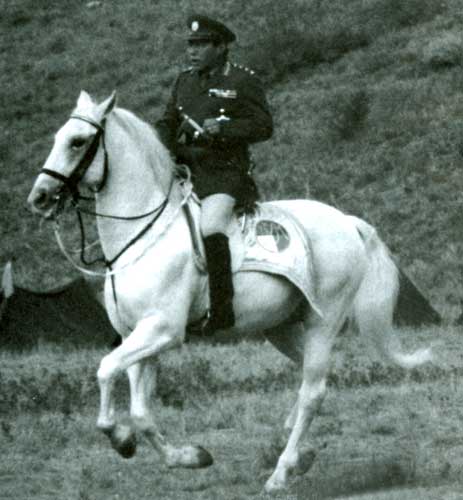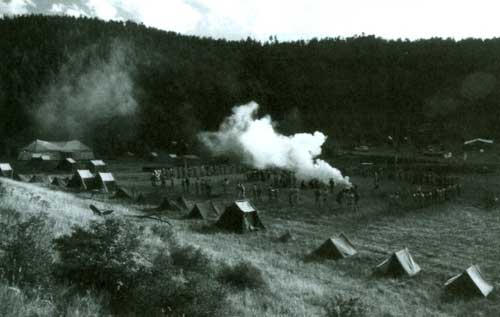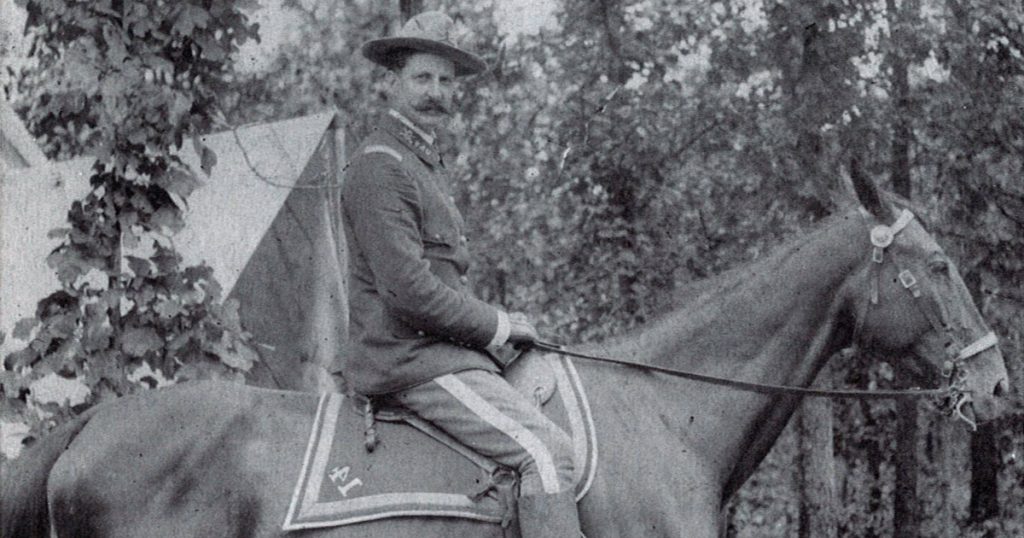It was an unanticipated homecoming for me, addressing a West Point audience on military matters a few years ago. My original connection to the United States Military Academy runs through my great-grandfather, class of ’77, who’d gone on to win the Congressional Medal of Honor for action against a Native American uprising in the Southwest. His son, my grandfather, graduated from the Academy in 1907; his only son, my uncle, went from Harvard to military intelligence in Korea, and from there to the CIA. But I became Buddhist soon after leaving high school, and I graduated from college as a conscientious objector, refusing the draft because of religious opposition to war of any kind. Yet, paradoxically, it was Buddhism that brought me back to West Point.
In 1975 I began studying with Chogyam Trungpa Rinpoche, a Tibetan meditation master who, in addition to retreats, schools, and monasteries, had his own military organization. This was the Dorje Kasung, or Vajra Guard, a group based on Buddhist principles of nonaggression—no one was armed, and we didn’t even practice the martial arts. Instead, this military was a means by which Trungpa Rinpoche taught dharma to a self-selected subset of students.
The very notion of a Buddhist military is itself rife with paradox. Yet this is an army whose aim is victory over aggression, rather than victory through warfare. Its fundamental principles respect the Buddhist precept against taking life, but they also respect all people and things. Instead of focusing on combat, then, this army is a form of Buddhist practice. Like all Buddhist practice, it is a form of mind training.
Trungpa Rinpoche was born in eastern Tibet in about 1939 and came to America by way of Oxford University, in 1970. He established a series of meditation centers across the United States and Europe and founded Naropa Institute (now Naropa University) in Boulder, Colorado. Though he died in 1987, the institutions he founded still flourish today under the direction of Shambhala International, based in Halifax, Nova Scotia. His students have been in many ways a conventional church group—people who hold day jobs and share variously in the community’s religious activities, keeping the books, maintaining the mailing list, teaching or taking a class at a local center, doing a solo meditation retreat. Some might also participate in the military, wearing blue blazers and gray skirts or trousers as they drive visiting Tibetan monks to the airport, escort a teacher to a talk, or act as security guards at public events. Here their practice has been the basic firmness of good manners, rooted in alertness and thoughtfulness, ready to say “No, you may not” or “Of course I will.” As such, it is an extension of training in mindfulness, awareness, and kindness, from which also arises the confidence to resist being pulled away from one’s center.
Many of us were doubtless working through difficult relationships with power and hierarchy—why else had we been drawn to this military?
Since the late 1970s members of this military have been invited to apply for a week-long summer encampment held in the Colorado Rockies or the hills of rural Nova Scotia. About eighty of us attended in any year. The style of practice combined monasticism with a boy—or girl-scout outing: khaki uniforms where one would traditionally find robes, individual pup tents in the place of cells, bugles or bagpipes instead of church bells, and drilling in formation in addition to more traditional forms of contemplative practice. My own motives for participating? The desire to get into the outdoors with good old friends and to satisfy my curiosity about this odd practice.
In early years we’d rise at 6:30, wash or shave in hand mirrors, eat breakfast from our mess kit, and sit in meditation—outdoors, on the ground, in our jungle boots—for an hour. One afternoon there was a wedding. Trungpa Rinpoche might give a talk in the evenings. Gradually, further Buddhist practice forms seeped through the encampment. In 1979 he introduced oryoki, the Zen style of eating from three nested bowls. Meals began with chants and were conducted in silence; formal hand gestures indicated when one wished more food. After eating, each soldier was served hot water with which to clean his or her bowls. Thus oryoki became our new mess kits. Later Shibata Sensei, a Japanese archery master, designed an outdoor shrine room for us, where the decorum of indoor meditation could flourish on the rugged earth.
But it was marching that distinguished the encampment from anyone’s previous experience of a meditation retreat or camping out in the woods. Much of the morning and afternoon, especially at first, was given over to the practice. It was real army drill. Our sergeant major was a white South African, trained in their army before becoming Buddhist and emigrating to North America. The physical movements, the commands, and our responses were as close to that form as we could manage.
Only a few of us had had previous military experience, and at first we weren’t especially good at drill. I in particular had difficulty getting my arms to swing right—they were always too tight or too loose, too controlled and stiff or too woggly. As a college freshman I’d been inducted by my Chinese teacher into the local ballet school’s Christmas production, which had a chronic shortage of males. As “court dancer” I’d walked through simple steps with a beautiful costumed young woman on my arm. Drill was less romantic, but as I mimicked the steps, it rather resembled klutzy open-air ballet.
The tone, though, was different from both ballet school and the conventional military. The sergeant would yell at me (“Peas in a piss-pot” and other bits of nifty foreign military slang). But it was not possible for him to insult or demean me, to soil the place—his authority was transparent, fictive, created by our participation in this creation of our teacher. So I worked hard to make drill beautiful, sharp, and powerful. If I didn’t get it right, it really didn’t matter very much. And if I did get it right—which by the end of the week I had somewhat accomplished—it didn’t matter very much either. Each way was equally perfect within that vast space, that expanse, unstated, unstatable, of which the mountain atmosphere was a tiny simulacrum.
From that space, we Buddhists say, arises dance, thought, compassion, mind, everything. It was the experience of that huge space that particularly marked and defined our activity, that distinguished our drill from that of other military organizations. It was the container, and also the foundation, and also the inseparable nature of these forms that we practiced and thus transformed.

And in the process drill became meditation. Sharp attention to the details of physical movement. A clear awareness of the expanse around them. As with meditation on the breath, such movements defined our attention only in the moment, disappearing as they occurred. However demanding the details, they did not fully occupy our minds, which remained precisely focused and widely opened—at once alert and relaxed. And nothing was accomplished, except mind arising unobstructedly within our activity. Thus meditation in action.
One of my reactions was to feel grounded in simplicity, nothing to gain or lose. I recalled the image of Fudo, the fierce, enflamed Zen deity whose name means “unmoving”—unable to be thrown off my seat, I was fully connected but at the same time imperturbable. No one could fuck with me. Nor had I any wish to fuck with anyone. At the same time this certainly wasn’t my power, neither originating from, nor located in, any familiar sense of myself. It was rather a quality that had become publicly and generally available due to our practice. Bound by attention to the forms of practice, each of us, relinquishing smaller aims, discovered that self-existent field of power.
Another reaction was wonderment, as when something seeming solid shows its transparent nature and an unexpected vista falls open before you: the dearness of all creatures, rocks and earth, the huge life-force of the waterless highlands of our midcontinent. Accompanying this was a light and generous absurdity. As Trungpa Rinpoche put it in the slogan he bestowed on his military: “If you can maintain your sense of humor and a distrust of the rules laid down around you, there will be success.” Absurd, but also most precise and dignified, the unfolding of our dance, no star performers, only movement, mountains, the power of gestures, a naked ritual with no reference point outside itself.
And so the military forms of my forefathers were purified and transformed. In that moment aggression became superfluous, untenable—I had lost all inclination to it. Nor could traditional military hierarchy find a purchase on me. It was a first step toward victory over war.
One sunny afternoon our squad was policing the camp—thirty people in a single rank, double arms’ length apart, searching the ground for cigarette butts and trash. The officer in charge, somehow displeased, yelled that we’d have to do this all afternoon if we didn’t do it properly, to which we responded that it was such a beautiful day it would indeed be wonderful to do so.
That response wouldn’t work in most other environments, military or not. Aggression is plenty real, gritty and full of sorrow, all around us. And victory over war means learning how to work with all of it.
We’d rise at 6:30, wash or shave in hand mirrors, eat breakfast from our mess kit, and sit in meditation—outdoors, on the ground, in our jungle boots—for an hour.
How well did we do? We learned, sometimes, to spot parts of our aggression, loud and raw against this background of space, and let it pop with an embarrassed twitch, dissolve. But like that officer, we weren’t always able to tune into the generosity of something large beyond thinking. Many of us were doubtless working through difficult relationships with power and hierarchy—why else had we been drawn to this military? Encampment was physically inconvenient, and some city guys never got used to sleeping on the ground in their clothes. Combined mild irritants enhanced our basic ego-tendencies, strengthening our habitual patterns and sometimes reconverting those military forms we thought we had transmuted. On one occasion Trungpa Rinpoche reviewed the troops, each of us standing stiffly at attention beside our pup tent as he walked round the camp circle. Gathering us together just after, he remarked, “It makes me sad that none of you soldiers was brave enough to smile when I walked past.” Thus while encampment intensified our neurotic reactions, it also provided a space in which these distortions of our true nature became apparent to all.
Trungpa Rinpoche also found ways to heighten our paranoia, and then release it. In Colorado our entire water supply rested in a large, wheeled tanker, hauled up creaking from the valley below. I was on sentry duty late one sagebrush-scented night, when a shout rattled through the camp: someone had cut the tanker’s hose, and four days’ water had flowed away. Had anyone spotted a lurker? Was a saboteur concealed among us? The whole camp was roused, soldiers fell out in uniform and stood at attention, while busy officers sought intelligence from the groggy night. Orders came from somewhere for drill. Then we were before Trungpa Rinpoche, presenting ourselves one by one for interrogation. As I approached him, I was given a splosh of Tabasco in my palm to lick as a kind of truth-oath. Then in his Oxford-accented tenor he asked me, “Kidder, did you cut the hose?” “No, sir!” I replied, and gave him a wet kiss on the cheek. And eventually we were all back to bed.
At some point in that goofy midnight exercise it occurred to me that only one person would have enjoyed cutting the hose: Chogyam Trungpa Rinpoche. It perfectly disrupted our normal sense of things, giving him and us the occasion for a joyful confusion, as soldiers sought earnestly for external enemies—a traitor? pranksters? militant pacifists?—only to find nothing there but the habits of our own mind. Still more, we met him eye to eye for a brief meditation interview, snatched out of our normal time for sleep. No perpetrator was ever identified, and nothing explained. It was left to each of us to figure out what had happened or to hear it from a friend, like the secret punch line of an intensely practical joke. And thus our paranoia was self-liberated.

But other teaching situations demand other means. In the front lines of daily life, long after encampment ends, and long before it ever began, we are surrounded by great swirls of our own and others’ aggression. How to meet it? It’s essential to maintain forms of practice—forms of kindness and attention—so that our harmful impulses can find ways to be re-formed. I once asked a Buddhist friend why he thought Trungpa Rinpoche had instituted the military. “Well,” he said, “how would you work with X?”, naming someone widely regarded as an impossible asshole. Hence the creation of an institution that could accommodate not only someone like me, a mild-mannered college professor, in the full range of my X-rated manifestations, but that also possessed the widest emancipatory power, with practice forms capable of shaping people of varying temperaments, abilities, interests, even using an obsession with authority or violence as bait in the transformation of some men and women who might never bring dharma to their lives through any other means. But the military was much more than a means of working with the unworkable. It was a provocation of the full gamut of our karma, like tossing a vajra (Tibetan symbol of the indestructible and indivisible reality) into the aggressive heart of America.
There was no real Tibetan precedent for these military forms. Instead, they were Trungpa Rinpoche’s own response to the energy of this country, his reshaping of pieces of our past and present. What guides the teacher in his or her creation of form? Is there a set of ethical principles that might contain it? An early Indian text, the Digha Nikaya, offers a hint to why there isn’t. The following passage, from Wm. Theodore de Bary’s The Buddhist Tradition, describes the Buddha (referred to as “the monk Gautama”) in his relationship to five moral fields—taking life, theft, improper sexual relations, lies, and slander:
The monk Gautama has given up injury to life, he has lost all inclination to it; he has laid aside the cudgel and the sword, and he lives modestly, full of mercy, desiring in compassion the welfare of all things living.
He has given up taking what is not given, he has lost all inclination to it…
And so the text continues through sexual relations, lies, and slander.
He has lost all inclination. He desires in compassion. That’s all it says. There are no commandments or guarantees, no higher authority. The foundation of all Buddhist ethics, then, is only the propensities of Buddha-mind.
Ultimately this is your mind. Before we’re fully confident of this, though, before our own actions emerge unobstructedly from space, before we discover our own power to create form, how do we make choices? How do we decide if it’s good to join the military, or to follow our teacher’s commands? After all, the Tibetan Buddhist master is very much a guru, someone to whom the student in varying degrees entrusts his/her life. And this hierarchy can be as severe as that of any military.
There is no certainty within this relative truth, and we are stuck here several ways at once. We rely on our basic decency, yet we must also step out of habit. We learn to trust ourselves, yet we wonder if that self exists and how far it’s reliable. Our teacher is steeped in lovingkindness, but her compassion may sometimes seem opaque and therefore may not quite reach our hearts. From practice, we get hints of something hugely good, but in fragments. Gradually we may come to fully trust our guru, but how can we do this before we know his mind and ours is the same? This is relationship with a spiritual teacher. The military practice intensifies it, reminding us how much is at stake, and of the traditional efficacy and danger of the tantric path, which works not only with the milder forms of human life but also with the ungainly, the disturbing, with alcohol, sex, and, in this case, with raw aggression, turning that fierce energy into a means to free all beings.
Today I live in Maine, in a small town that shares its space with the vast and open runways of a naval air station. Among the moms and dads of my daughter’s friends are several military people with whom I feel a profound yet uncertain fellowship. I suspect that, like my great-grandfather, they may have found the American military ennobling. I wonder if it has also allowed them to purify their own aggression until, seeing through the disciplines of form, they can offer protection to all beings in need.
Thank you for subscribing to Tricycle! As a nonprofit, we depend on readers like you to keep Buddhist teachings and practices widely available.
